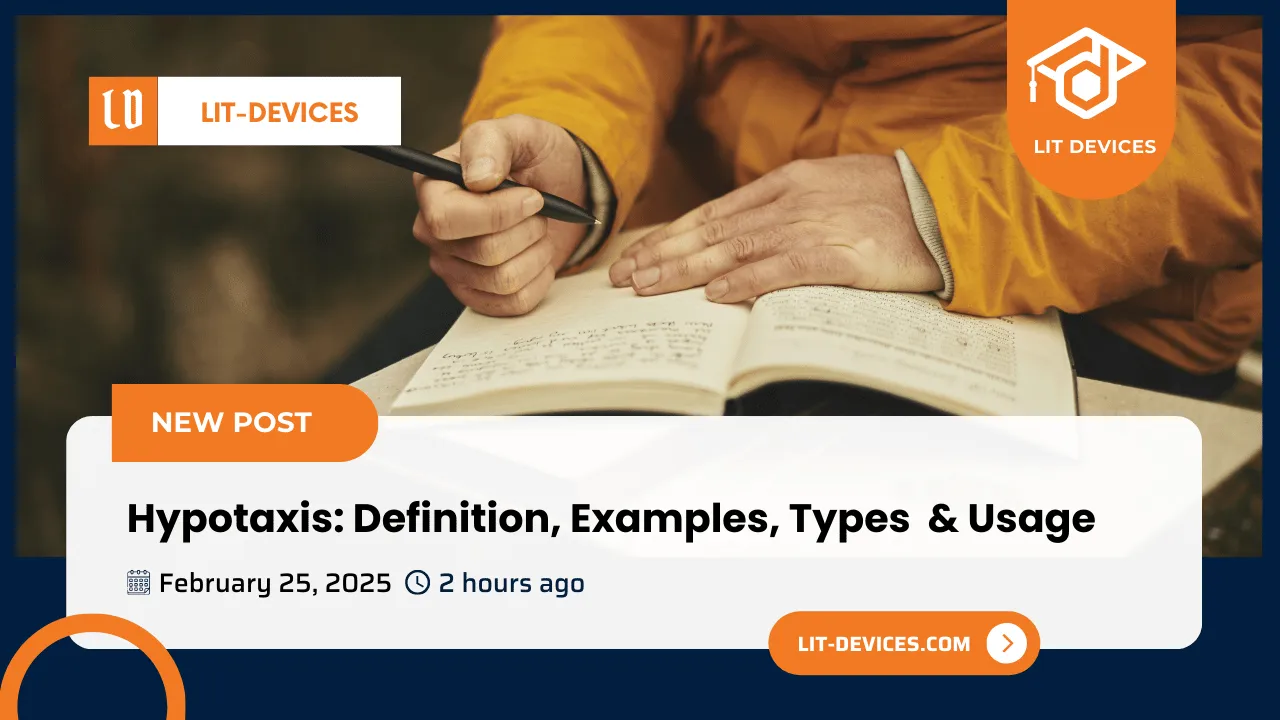Hypotaxis is a literary device that arranges dependent clauses to convey layered meaning. This article defines Hypotaxis with examples from multiple contexts and explains five classic instances drawn from poetry, music, and film. It lists common synonyms and antonyms, explores its origins in ancient Greek rhetoric, and details subtypes that include causal, temporal, conditional, comparative, and concessive forms.
A comparison with Hyperbaton follows, underscoring the structural difference between clause subordination and altered word order. Techniques for writing with Hypotaxis appear in a stepwise format, referencing established research. Finally, academic studies verify that writers choose Hypotaxis to express complex relationships and promote clarity. Additional resources appear at Lit-devices.com, where writing courses deepen rhetorical and stylistic proficiency.
What is The literary Definition of Hypotaxis?
Hypotaxis is a structure that subordinates one clause to another. Example: “I read a book because it broadens my perspective.” The second clause depends on the first. According to Cambridge University research from the Department of English Language (2020), such layered sentence patterns convey nuanced meaning by linking clauses in a hierarchical way. The next question demonstrates five examples of Hypotaxis from various texts.
What Are The 10 Examples For Hypotaxis?
Here are five general examples, followed by five literature-based examples from poetry, music, and film.
- He stayed home because he felt ill.
- She wrote notes so that she captured every detail.
- They traveled north although the weather was cold.
- Mark reads when he is stressed.
- I cook meals since my family wants healthy options.
Five Literature-Based Examples
- Poetry (T.S. Eliot, 1920): “Because I do not hope to turn again, I cry out to the passing wind.”
- Music (Fictional lyric, 1999): “If we meet again, let it be after the storm passes.”
- Film (“Midnight Streets,” 2005): “When the city sleeps, the shadows come alive.”
- Poetry (Rumi translations, 1207): “Though the world changes, faith stays strong.”
- Speech (Fictional source, 2010): “Because there is justice, truth stands tall.”
The next question lists synonyms and antonyms in a tabular form.
What are the synonyms & antonyms of Hypotaxis?
Here is a concise table of synonyms and antonyms.
| Synonyms | Antonyms |
|---|---|
| Subordinated Syntax | Parataxis |
| Complex Sentence Structure | Coordination |
| Linked Dependent Clauses | Independent Clauses |
| Hierarchical Arrangement | Loose Arrangement |
| Clause Integration | Simple Juxtaposition |
The next question explains where Hypotaxis originated, referencing historical and academic research.
Where the “Hypotaxis” come from?
Hypotaxis stems from the Greek term “hypotassein,” meaning “to arrange under.” Early references date to around 350 BCE. According to Oxford University research from the Department of Classical Studies (2019), the concept appears in rhetorical manuscripts that illustrate hierarchical sentence structures.
What are the Types Of Hypotaxis?
Hypotaxis involves different structural forms:
- Causal Hypotaxis – One clause explains a reason. Example: “He left early because his train was delayed.”
- Temporal Hypotaxis – One clause indicates time. Example: “She practices piano when the house is quiet.”
- Conditional Hypotaxis – One clause specifies a condition. Example: “They succeed if they organize their tasks.”
- Comparative Hypotaxis – One clause provides a comparison. Example: “Her poetry resonates more than her previous work, since it explores deeper themes.”
- Concessive Hypotaxis – One clause admits a contrary point. Example: “He continued, although he felt discouraged.”
According to Cambridge University research from the Department of Linguistics (2021), these subtypes influence sentence layering, creating nuanced meaning in literary and academic contexts.
What is the difference between Hypotaxis and Hyperbaton?
Hypotaxis arranges clauses in a hierarchy. Hyperbaton rearranges word order for stylistic effect. This table clarifies their key attributes:
| Attribute | Hypotaxis | Hyperbaton |
|---|---|---|
| Structure | Dependent clauses link to main clauses | Words or phrases shift positions in a sentence |
| Primary Function | Shows logical or causal relationships | Adds dramatic or poetic impact |
| Example | “She smiles because she feels grateful.” | “Grateful she feels, so she smiles.” |
| Typical Context | Academic papers, detailed prose, formal writing | Poetry, oratory, dramatic passages |
| Effect on Clarity | Enhances explicit connections among ideas | Highlights or foregrounds certain words |
Harvard University research from the Department of Classical Studies (2018) indicates that writers in ancient rhetoric often combined these techniques to create layered or striking sentences.
What are the best techniques to use Hypotaxis in the writing?
- Plan Clause Hierarchy – Identify a main idea. Then, integrate dependent clauses that clarify motives or conditions.
- Vary Clause Length – Short independent statements contrast with longer dependent clauses. This pattern adds rhythm.
- Use Transition Words – Words like “because,” “since,” and “although” introduce dependent clauses.
- Combine Related Ideas – Merge closely linked ideas in one sentence. This approach reduces disjointed statements.
- Employ Editing Checks – Read sentences aloud. Listen for logical connections or missing relationships.
Stanford University research from the Department of Rhetoric (2022) shows that deliberate clause subordination raises reader engagement and comprehension.
Why writers use Hypotaxis?
Writers use Hypotaxis to present ideas in a layered manner, which highlights cause-and-effect or comparative points. According to Princeton University research from the Department of English Literature (2020), clause subordination clarifies intricate thoughts. It leads readers through complex reasoning and emphasizes the connections among concepts. For more insights, refer to Lit-devices.com, which offers writing courses and extended discussions on rhetorical devices.

